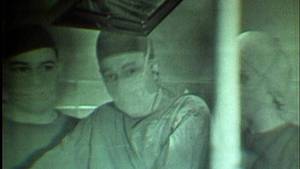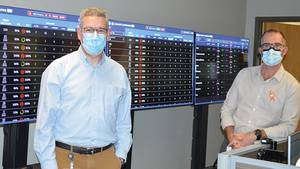The stats speak for themselves: 99 per cent of patients reported 100 per cent satisfaction. These are the results of a surveyof patients who have visited the new Cardiology Nurse Practitioner Access Clinic.
“That’s really what it’s all about,” says QEII Health Sciences Centre Cardiology Nurse Practitioner Debbie Oldford.
With increasing demands for service delivery, healthcare providers everywhere are looking for ways to optimize efficiency and reduce wait times. Cardiology at the QEII is no exception; the role of the nurse practitioner is alleviating the demand and improving bedside care.
The role is becoming increasingly important in health care. A nurse practitioner is a registered nurse who has completed an advanced practice nursing degree. This role is a primary, direct health care provider who diagnose and treat illnesses and injuries, order and interpret tests, prescribe medications, and initiate appropriate interventions.
“We act in the role of clinician, consultant and advocate, professional leader, educator, and researcher — combining advanced nursing practice, evidence research-based knowledge and leadership skills to plan, coordinate, implement and evaluate the care of adults in cardiology,” Oldford says.
Through increased services, such as telephone management, nurse practitioners can assess and aid patients over the phone, resulting in a marked decrease in emergency visits.
“We help patients through life-altering changes,” says Oldford. “Having the opportunity to empower patients to manage their own care — like heart failure management with sodium, fluid restriction, daily weights and smoking cessation — is extremely satisfying. We can facilitate patients through their healthcare experience. We learn something new every day by working one-on-one with experts in the field and members of the multidisciplinary team.”
Cardiology Nurse Practitioner Natalie Nichols notes that the development of the access clinic came through a submission by nurse managers and physicians.
“As nurse practitioners, we had always hoped for an out-patient clinic,” she says. “The Nurse Practitioner Access Clinic was created to try to assess low-risk cardiology referrals in a timely fashion. The wait list for this patient population was unacceptable —sometimes 32 weeks.”
Nichols says patients are usually seen in the access clinic within six weeks, but many have only waited one to two weeks. The clinic averages 120 to 150 patients a month.
Cardiology nurse practitioners work in the Heart Function Clinic, in-patient ward and the Nurse Practitioner Access Clinic, on a rotational basis. The purpose of the access clinic is to work within a collaborative-practice approach between a nurse practitioner and a cardiologist.
“Patients tend to have palpitations, atypical chest pain or new murmurs. The great part about the clinic is that usually the required testing is done before we see the patient. We can see them once, and often they don’t need follow-up. Of course, we also see patients who require admission, or who fail the stress test and require urgent follow-up.”
Nichols and Oldford presented their experience at the Canadian Cardiovascular Congress in Vancouver in 2011 for the Canadian Council of Cardiovascular Nurses. Nurse practitioner clinics, like the one established at the QEII, are responding to a nationwide need.
“We act as intermediaries and can translate the medical jargon into words that are meaningful to patients,” Nichols says. “We are able to spend time explaining the plan of care, how the tests are done, educating the patients on their disease or test results, and reassuring them that the tests will be done. We give them estimates on the wait time for different procedures.”
Cardiologist Dr. Robbie Stewart is the physician co-leader for the Cardiology Nurse Practitioner Clinic and works with seven other cardiologists in the clinic.
“There has been extremely favourable feedback, both from physicians and from patients,” he says. “Patients appreciate the time that the nurse practitioners spend with them, and they have the opportunity to further review the management plan with a cardiologist.”
Dr. Stewart says nurse practitioners assist cardiologists by providing comprehensive clinical assessments, taking histories, performing physical exams, interpreting tests and making independent management decisions with patients.
“However, that description really doesn’t give an accurate idea of all that the nurse practitioners provide. These care providers bring a very patient-focused, holistic approach that acts as a complementary point of view to what we, as physicians, offer as heart specialists.”








